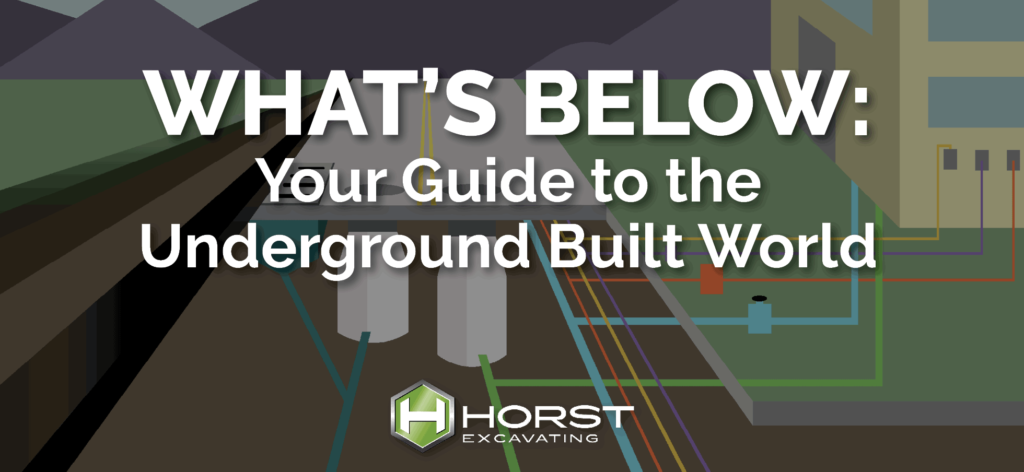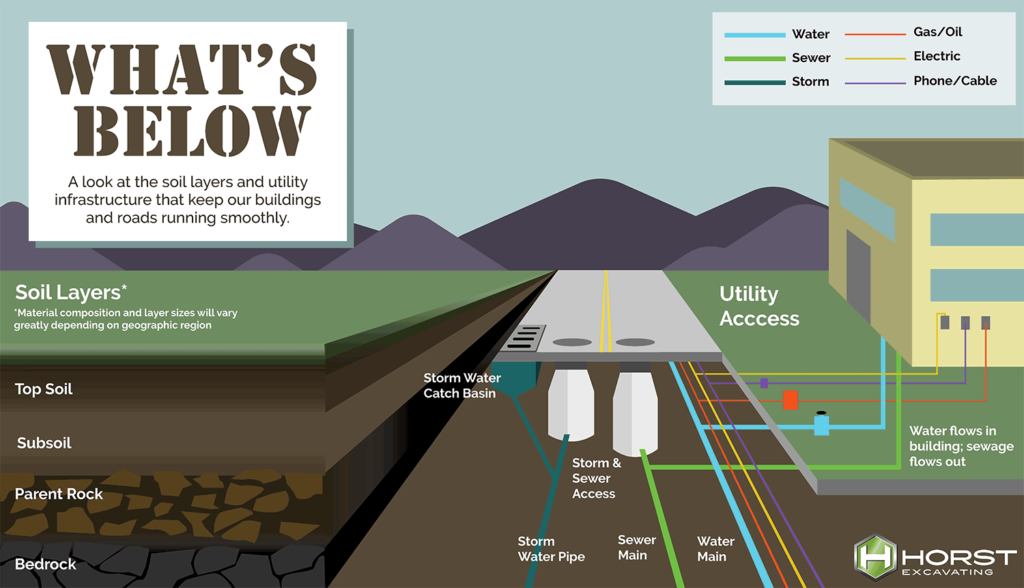What’s Below: Your Guide to the Underground Built World
As an excavating and site work team, we spend a good bit of time thinking about the ground beneath our feet.
And while that may sound incredibly boring, we promise it’s not. Many don’t realize how complex and essential our underground infrastructure is. These systems are responsible for so many of the modern conveniences we increasingly depend on.
In the world of construction and excavating, understanding the type and location of these systems is crucial for a successful project, whether you’re developing a new site or renovating an existing one.
In this blog, we’ll uncover this intricate network of underground utilities and the layers of soil that house them so you can understand what shapes our underground landscape.
Soil Layers
The earth that lies below our feet is a unique composition of particulates. While the exact type of soil varies greatly based on location, most of the ground we build can be broken down into a few different layers. The size and composition of these layers can impact how the site is developed.
- Topsoil: This top layer of dirt is rich with nutrients and perfect for supporting plant life, making it an essential component in landscaping. Teams must take action both during and after construction to ensure topsoil is preserved and held in place against erosional factors like wind and rain. This includes stockpiling it on site for later use, erosion control fences and blankets, regrading, proper drainage, and planting vegetation.
- Subsoil: Beneath the topsoil layer lies the subsoil. This layer is typically composed of minerals, clay, and other materials. As it typically extends several feet below the surface, subsoil composition can have a significant impact on a project. Composition can vary greatly, including varying amounts of clay, rock, sand, gravel, and more. This will impact factors like soil expansion and contraction, water retainage, and the amount of weight it can support. Learn more about how soil type affects construction in this blog.
- Parent Rock: Parent rock sits below the subsoil and gets its name from being the source of the material that lies above it. As water, oxygen, and other components gradually weather away at this layer, subsoil forms. Parent rock layers influence the stability and load-bearing capacity of the ground above.
- Bedrock: At the bottom is bedrock. This solid and stable rock that has not been weathered by erosional forces. It can play a crucial role in supporting heavy structures built above.
Keep in mind the land on your site will have a unique soil and soil layer composition. Having a design and construction team that understands your site’s composition is essential to a long-lasting building.
Stormwater Infrastructure
Stormwater systems collect rainwater runoff from the built environment and safely divert it into waterways or groundwater. Tasked with reducing flooding and erosion, there are several types of these systems commonly employed on projects. They include things like detention and retention ponds, rain gardens, permeable pavement, green roofs, and more.
Much of the related infrastructure for these systems lies aboveground, working to collect and then slowly release water into the ground or drainage systems. But depending on the type of system, below could lie a network of basins and pipes to divert water elsewhere.
This would include things like stormwater catch basins, stormwater access areas, and stormwater pipes.
Pipes may run from rooftops and underneath roads and parking areas, carrying water runoff from the non-permeable surface to the retention basin. Some of these are equipped with sediment chambers, which help capture pollutants before they enter our waterways.
There may be other pipes or weirs under the retention basin itself that help control the flow of water from the basin to the body of water it empties into. Some systems may also be designed to store water underground during peak flow periods, preventing the inundation of local water sources with water and reducing flooding.
Other Utilities
- Sewer Access: We can thank our modern sewer systems for their pivotal role in community health and hygiene. Tucked away safely belowground, sewers and their related infrastructure are one thing we’re happy to have a few feet of earth separating us. From pipes and mains diverting sewage from buildings to treatment centers to the access points for maintenance professionals, a vast network lies below us, managing waste hygienically and safely. Depending on the project, excavators may install a new system or expand an existing system to accommodate the needs of growing communities.
- Water Mains: Another modern marvel that’s easy to take for granted is the municipal water supply. At the other end of the cycle from our sewer infrastructure, water mains bring clean water into our buildings. Once we use it, it’s carried from our buildings via the sewerage systems.
- Gas & Oil Lines: Natural gas and oil are crucial components of our world’s current energy portfolio. Oftentimes, the safest and most efficient way to transport these materials is through underground pipes. Working with underground lines takes experience and precision. A careful team can install, expand, or repair this necessary infrastructure to meet your buildings’ needs.
- Electric, Internet, & Cable Lines: Electric lines are another near-essential utility. While in some areas the infrastructure is above-ground, in other areas they carefully crisscross underground. These need to be carefully navigated during site work on a previously developed site. The same goes for the internet and other communication lines. While accidents can always happen, the right approach, equipment, and skill can ensure your project goes smoothly.
Finding the Right Partner
As we look below, it becomes clear that the underground built world is a complex marvel of engineering that’s responsible for keeping so many of our tools and appliances running. From electricity to water to flood-reducing stormwater systems and more, we depend on this equipment every day.
At Horst Excavating, we have expertise in working with many types of soil and underground utilities, whether that be installing new or navigating around existing systems. We utilize cutting-edge technology and geotechnical tools to plan and execute our projects in a more precise manner.
The hidden world under our feet is no match for the dedication and skill of our team!
Posted January 18, 2024



